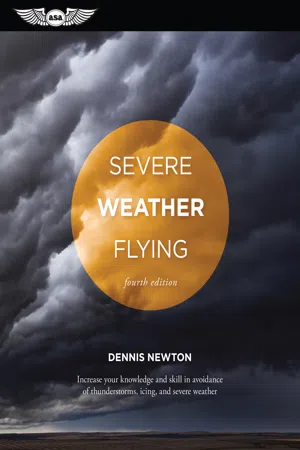
Severe Weather Flying
Increase your knowledge and skill to avoid thunderstorms, icing and severe weather
- 212 pages
- English
- ePUB (mobile friendly)
- Available on iOS & Android
Severe Weather Flying
Increase your knowledge and skill to avoid thunderstorms, icing and severe weather
About This Book
At the outset of Severe Weather Flying, author Dennis Newton reminds readers that this book is not about flying in severe weather, but rather how to detect and therefore avoid it, with advice on how to escape it if you become caught in it accidentally. Newton is a meteorologist, weather research pilot, engineering test pilot, ATP, and flight instructor. He speaks pilot-to-pilot in this valuable guide on how not to fly severe weather. He believes that given the knowledge, pilots can truly lessen their chances of being caught in thunderstorms and other extreme weather conditions.The emphasis is on types of weather that are potentially hazardous to flight; with each type of weather discussed, the author provides rational answers to a pilot's very sensible question, "And then what? How does this affect me?" He also discusses the capabilities and limitations of airplanes and equipment in avoiding and in dealing with severe weather.Meteorology can be a tough "language" and not always clear to the lay person. The author translates and brings across the most crucial principles pilots can use to fly more wisely in weather. Covering weather fundamentals, the atmosphere, and the stability of the air, he then digs deeper into the individual aspects of severe weather situations: air mass and nocturnal thunderstorms, downbursts, lightning, icing, turbulence and wind shear.In print for more than 30 years, this book in its Fourth Edition blends in good coverage of detection equipment for the cockpit, and the weather briefing information available to the pilot for decision-making in flight planning — even the enroute phase. Details on aircraft icing certification, critical aircraft icing information, and high altitude ice crystals are also included.
Frequently asked questions
Information

- Water. All weather (except some of the winds which serve to move the water around) is made of water. Icing clouds are made of water. Thunderstorms are made of lots of water. Water, of course, is everywhere. About two-thirds of the planet is covered with it. Water to make weather out of enters the air from oceans, lakes and rivers. It is no coincidence that some of the most treacherous weather in the world occurs in the area of the Great Lakes. Enough water to make a lot of weather can even come right off the ground, particularly after a rain. Everyone has seen a day begin to dawn bright and clear after a night rain, only to sock in tight as the morning heating lifts water into the air. When you look at any sort of weather chart, ask yourself where the water is. What are the dew points? Are the winds coming from dry land, or from a source of moisture? Water is the enemy.
- Temperature. Various types of weather require temperatures in various ranges. Icing, for example, requires temperatures somewhat, but not too much, below freezing. Fog requires temperatures near the dew point. Thunderstorms require relatively warm temperatures in the lower layers of air in which they form for the simple reason that warm air can hold more water. There is even some correlation between temperature and lightning strikes to aircraft.
- Lifting. Very early on, you are likely to find in most basic weather texts for pilots some statements to the effect that low-pressure areas are associated with obnoxious weather. Why should this be true, you might ask yourself. It’s really quite simple. Air is drawn into the low near the surface. It comes in from all directions, so it has no horizontal way out. Air is very nearly incompressible at natural wind speeds, so it can’t just pile up in the low-pressure center. Where does it go? The only way left: Up. Voilá! If moisture is present in sufficient quantity, the result is weather. It is a small oversimplification indeed to say that all a front does is lift air. There are such things as sea breeze fronts and dew point fronts, in addition to the commonly known cold, warm and occluded fronts, which are in the business of lifting air. The jet stream, and other smaller-scale upper-air wind flows, create “holes” in the upper air that result in lifting of low-level air to fill them. Hills lift air. A thermal over a hot parking lot surface lifts air.
- Stability. This is one of the most important factors in weather, and one of the least understood. If you want to understand thunderstorms, icing, or any other kind of weather for that matter, you have to understand stability. Fear not. Stability is very simple and even fun—it is only the explanations that are weird and mysterious. More on the subject is forthcoming.




Table of contents
- Copyright
- Preface
- Introduction
- Abbreviations
- 1: The Four Fundamentals
- 2: The Ups and Downs of Air
- 3: Stability
- 4: Air-Mass Thunderstorms
- 5: In This Corner, Mama Bear
- 6: Will the Real Papa Bear Please Stand Up?
- 7: The Downburst
- 8: Lightning
- 9: Thunderstorm Weather Briefing
- 10: Nocturnal Thunderstorms
- 11: Thunderstorm Detection Equipment
- 12: Hows and Whys of Icing
- 13: The FAA Aircraft Icing Plan
- 14: Icing Weather Briefing
- 15: In-Flight Icing Strategies
- 16: Ice Protection Equipment
- 17: Icing Certification
- 18: Supercooled Large Drop (SLD) Icing
- 19: High Altitude Ice Crystals
- 20: Nonconvective Turbulence and Wind Shear
- Appendix
- About the Author
- Index